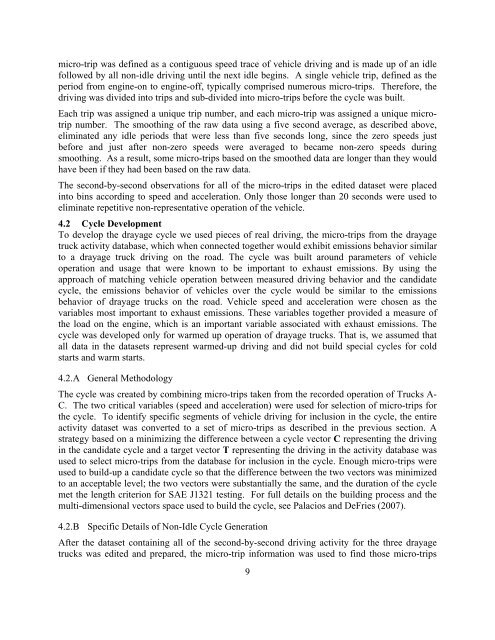NTRD-02 Final Project Report The Effects of Low Rolling Resistance ...
NTRD-02 Final Project Report The Effects of Low Rolling Resistance ...
NTRD-02 Final Project Report The Effects of Low Rolling Resistance ...
You also want an ePaper? Increase the reach of your titles
YUMPU automatically turns print PDFs into web optimized ePapers that Google loves.
micro-trip was defined as a contiguous speed trace <strong>of</strong> vehicle driving and is made up <strong>of</strong> an idle<br />
followed by all non-idle driving until the next idle begins. A single vehicle trip, defined as the<br />
period from engine-on to engine-<strong>of</strong>f, typically comprised numerous micro-trips. <strong>The</strong>refore, the<br />
driving was divided into trips and sub-divided into micro-trips before the cycle was built.<br />
Each trip was assigned a unique trip number, and each micro-trip was assigned a unique microtrip<br />
number. <strong>The</strong> smoothing <strong>of</strong> the raw data using a five second average, as described above,<br />
eliminated any idle periods that were less than five seconds long, since the zero speeds just<br />
before and just after non-zero speeds were averaged to became non-zero speeds during<br />
smoothing. As a result, some micro-trips based on the smoothed data are longer than they would<br />
have been if they had been based on the raw data.<br />
<strong>The</strong> second-by-second observations for all <strong>of</strong> the micro-trips in the edited dataset were placed<br />
into bins according to speed and acceleration. Only those longer than 20 seconds were used to<br />
eliminate repetitive non-representative operation <strong>of</strong> the vehicle.<br />
4.2 Cycle Development<br />
To develop the drayage cycle we used pieces <strong>of</strong> real driving, the micro-trips from the drayage<br />
truck activity database, which when connected together would exhibit emissions behavior similar<br />
to a drayage truck driving on the road. <strong>The</strong> cycle was built around parameters <strong>of</strong> vehicle<br />
operation and usage that were known to be important to exhaust emissions. By using the<br />
approach <strong>of</strong> matching vehicle operation between measured driving behavior and the candidate<br />
cycle, the emissions behavior <strong>of</strong> vehicles over the cycle would be similar to the emissions<br />
behavior <strong>of</strong> drayage trucks on the road. Vehicle speed and acceleration were chosen as the<br />
variables most important to exhaust emissions. <strong>The</strong>se variables together provided a measure <strong>of</strong><br />
the load on the engine, which is an important variable associated with exhaust emissions. <strong>The</strong><br />
cycle was developed only for warmed up operation <strong>of</strong> drayage trucks. That is, we assumed that<br />
all data in the datasets represent warmed-up driving and did not build special cycles for cold<br />
starts and warm starts.<br />
4.2.A General Methodology<br />
<strong>The</strong> cycle was created by combining micro-trips taken from the recorded operation <strong>of</strong> Trucks A-<br />
C. <strong>The</strong> two critical variables (speed and acceleration) were used for selection <strong>of</strong> micro-trips for<br />
the cycle. To identify specific segments <strong>of</strong> vehicle driving for inclusion in the cycle, the entire<br />
activity dataset was converted to a set <strong>of</strong> micro-trips as described in the previous section. A<br />
strategy based on a minimizing the difference between a cycle vector C representing the driving<br />
in the candidate cycle and a target vector T representing the driving in the activity database was<br />
used to select micro-trips from the database for inclusion in the cycle. Enough micro-trips were<br />
used to build-up a candidate cycle so that the difference between the two vectors was minimized<br />
to an acceptable level; the two vectors were substantially the same, and the duration <strong>of</strong> the cycle<br />
met the length criterion for SAE J1321 testing. For full details on the building process and the<br />
multi-dimensional vectors space used to build the cycle, see Palacios and DeFries (2007).<br />
4.2.B Specific Details <strong>of</strong> Non-Idle Cycle Generation<br />
After the dataset containing all <strong>of</strong> the second-by-second driving activity for the three drayage<br />
trucks was edited and prepared, the micro-trip information was used to find those micro-trips<br />
9

















